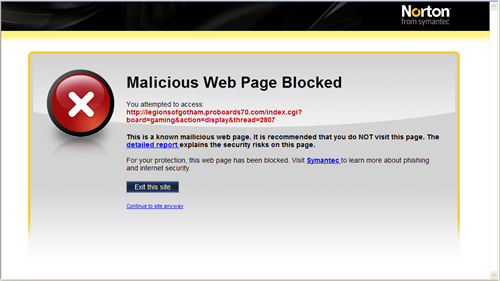 Symantec has launched the public beta program of a new product that aims to protect consumers while they browse the web. The company claims it is entering the market because current tools that show users which sites may be unsafe simply aren't up to par. Norton Safe Web is currently a plug-in for the beta of Norton Internet Security (NIS) 2009, which debuted last week. Once both products go final, it will be included in NIS.
Symantec has launched the public beta program of a new product that aims to protect consumers while they browse the web. The company claims it is entering the market because current tools that show users which sites may be unsafe simply aren't up to par. Norton Safe Web is currently a plug-in for the beta of Norton Internet Security (NIS) 2009, which debuted last week. Once both products go final, it will be included in NIS.
Norton Safe Web, which integrates itself into Internet Explorer or Firefox, has three main functions:
- Provide a trust visual indicator (green checkmark, yellow exclamation mark, red cross) on search results (Symantec hopes to eventually cover the first two or three pages) from Google, Yahoo, and Live Search
- Protects consumers from sites that can infect them or that might misuse their personal information
- Helps consumers identify sites they can safely do business with
Norton Safe Web will primarily help block websites that contain drive-by downloads. This will be done by redirecting users to a page that explains why the link clicked may be dangerous and offering exit and continue options. The trust visual indicators that appear beside links on search results will not interfere with the loading of the search page because the solution is asynchronous and server-side. Symantec is making sure that browser performance is not affected by Norton Safe Web.
Instead of trying to find threats across the whole Internet, Symantec will zero in on suspicious websites thanks to data feeds from third party sources and Norton Community Watch reports; Symantec claims that 81 percent of suspicious websites contain drive-by downloads. Third party feeds will be used as leads but will not be taken at face value (will not be marked with a red cross). Its own users also report 13,000 unique domains a day, 3,000 of which are unique.
Symantec has tried to create a community behind Norton Safe Web that encourages its users to contribute and participate. It almost looks like the company wants to put social networking to use for security purposes. A typical Safe Web report for a given website will include a rating summary, a snapshot of the homepage, detailed threat info, community rating, and user reviews.
Although the algorithm for deciding how to rate a given site has not been perfected for the beta, it will take various factors into consideration for rating a site as possibly containing malicious files: popularity, history of the site, how badly the site is infected, and how many users report it.



reader comments